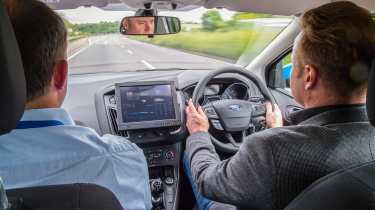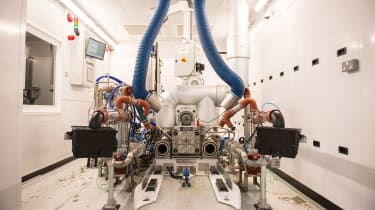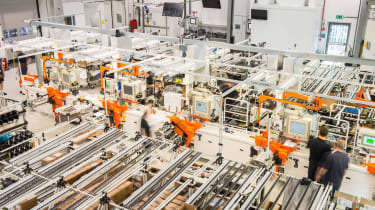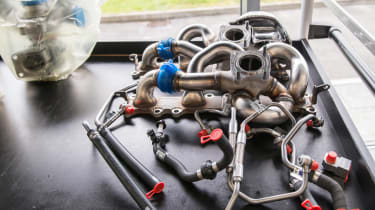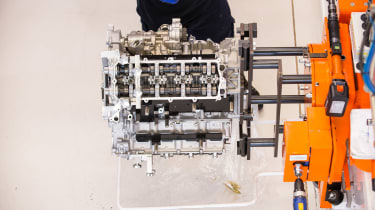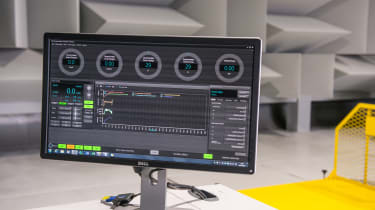Ricardo: A UK automotive innovator at the forefront of future car tech
Maker of more than engines and gearboxes, Ricardo is helping shape the future of motoring
You walk through its corridors open-jawed at the treasures within. Treasures such as Sir Harry Ricardo’s first internal combustion unit (a 2-litre single-cylinder pump engine built between 1901 and 1903) and a Mark V tank motor (Britain’s first mass-produced engine – used in WWI).
Then you see a viscous coupling (used in Group B rally cars and numerous road cars), a twin-clutch gearbox from the Veyron, the JCB Dieselmax engines, the latest Focus RS engine and then, the pièce de résistance, the huge hall where McLaren’s V8 twin-turbo engine is assembled. All are Ricardo designed, engineered or built. Some are all three.
This is a company proud of its history, as a recently opened Centenary Innovation Centre that celebrates its achievements shows. But it’s also a business looking forward – peering into the future and proposing solutions to cure some of the biggest headaches facing not only the motoring industry but the world. As a whole, it sees itself as a global environmental and technical consulting organisation.
Professor Neville Jackson, chief technology and innovation officer, says, ‘We’ve grown from the old days where we were focused on advanced powertrain R&D and now we consult at the top levels in government to give advice on long-term environmental strategy.’ Or in other words, Ricardo plays a huge part in shaping legislation – legislation that impacts on air quality, clean and sustainable energy, and waste management.
With a foot in both the performance car and environmental camps, few are better placed to discuss the challenges facing motorists, and particularly those who drive for pleasure.
Dieselgate and the electric car future
Mark Garrett, Chief Operating officer, joins Professor Jackson to host evo, and sure enough it doesn’t take long before dieselgate rears its ugly head (about 30 seconds). But how will this scandal shape future motoring? Jackson and Garrett are in no doubt that it will accelerate a move towards electric-powered cars.
‘I think the issues with VW and issues with urban air quality, the two of which are not related, have led a lot of the industry to realise that big shifts [towards electrification] are required,’ explains Jackson. ‘We’re going to electrify,’ adds Garrett, ‘the only real debate is how fast we do it.’
But it’s not just dieselgate that is causing a shift, explains Garrett. ‘We are seeing the megatrends of urbanisation, changing ownership structures, more wealth, more middle-class people, huge population growth.’ It’s these forces, claims Garrett, that are driving a rate of change in the automotive sector that has never been seen. In short, after 131 years of the motorcar, we’re only just entering its most significant phase of change.
‘It’s pretty clear that by 2020 at least half the models on sale will be electrified in some form or other,’ Garrett continues. ‘A recent study suggested that by 2030 there will be less than ten per cent diesel sold across Europe, which given we’re at 52, 53 per cent today is a massive shift.’
The risk is that this rapid move to electrification can’t happen without sound analysis and evidence. Dieselgate could impact on this, as governments and consumers want swift resolutions.
‘We’re in the situation we’re in today because we haven’t understood exactly what the impacts were likely to be in the past,’ says Garrett. ‘We’ve had relatively weak regulation but with over-optimistic assumptions on the impact that will have on the environment. We as an engineering community need to provide better analysis to the policymakers in order to make those future regulations more sensible and deliver what’s required.’
So what about the plan to ban cars built before 1997 from Paris? Is this an example of policymakers ignoring sound evidence? ‘We need to be able to show what the impacts of things are,’ says Garrett. ‘For instance, if you ban that sector, what’s the real impact? There’s a danger you might ban a group of vehicles then find it’s had no impact whatsoever, and the economic costs of that would be disastrous. It’s got to be based on sound scientific analysis and common sense. The last thing you want to see are knee-jerk reactions that don’t deliver what was expected, because we’ll all be in the doghouse again.’
Does Garrett think there’s the patience within the engineering and political communities to allow the science to deliver the rationale? After all, politicians exist in election cycles.
‘Quite frankly it is much easier to predict the technology than to predict what the policymakers will do,’ he says. ‘For instance, who would have guessed, this time last year, we’d have voted to leave the EU?’.
‘I think we’re all aware that politicians can use information to suit their own specific policy agenda, frankly,’ says Jackson. ‘It’s very much a case of using information appropriately and I think there are lots of different levers that the politicians will pull, in a lot of cases to get the right solution, but maybe not always through the most appropriate means.
‘There is an issue; it’s how you deal with it that’s going to be important. I think there are two agendas here. Most European governments, and US regulators as well, are trying to push the electrification agenda, primarily on air quality. Nothing to do with carbon dioxide emissions, it’s all about air quality. “Can I have more electric vehicles in the city centre?” That’s what it’s about.
‘On the other hand, the rate of change from what we would see as a conventional powertrain to a high degree of electrification represents a massive investment cost for the industry. The debate we’re having is how fast can you make that happen? How fast can you move to electrification while still staying in business, keeping people employed, using all those capital assets you’ve invested in and getting some kind of return for them?
‘It’s not so straightforward to manage that transition in a very short period. The industry is committed to doing it in the medium term, but to try to do it in the short term is a major financial challenge. Not only that, but to move to electrification, we need the infrastructure in place as well – the charging infrastructure. The more electric vehicles you have, the more charging stations you have, and the more you want to use them. Particularly moving long distances, the bigger batteries you’re going to fit means you need a more powerful recharging network, which has big implications on our charging infrastructure and our electricity-provision infrastructure.’
Garrett explains that the cost of switching to electrification can’t be underestimated, not only in terms of decarbonising the electricity supply but also the complexity involved in delivering high-power charge points in local areas. ‘Not only that, with things as they are, if everybody on a road tried to charge up, the whole thing will fall apart.’
A new generation and a new relationship with the car
Ricardo believes that the next generation of road users may rewrite the rules of car ownership and usage, and that manufacturers cannot ignore the growth of car clubs and sharing services such as Zipcar and Lyft. And in terms of the Thrill of Driving, surveys of 16- to 24-year-olds suggest that they’d rather spend their money on an experience rather than hardware to own.
However, one key development in any move to on-demand motoring is cars that are engineered to be better suited to their primary purpose.
‘With conventional ownership models, we have one powertrain that has to do everything from “I’ve got to drive into the city” to “I want to do some inter-city mobility” and “I want to move some things down to the refuse dump,”’ explains Garrett. ‘But what if the thinking was, “What kind of vehicle do I really need to suit my needs?” If there was a different ownership model, you could have the vehicle that you need, when you need it, for the purpose that it was intended. A small vehicle to go into the city, a different vehicle to go between cities, a larger vehicle if you needed to move things about. It works so much better and it means you can provide more dedicated powertrains for the purpose they’re best used for.’
Consequently, according to Jackson and Garrett, if a large market for on-demand motoring materialises, then the next generation of motor vehicle will be used more often – just not necessarily by the same person.
According to Jackson, most cars are in use less than five per cent of the time. If this increased via ‘i-mobility’ schemes, manufacturers could afford to put much greater levels of technology into a car, making it more fit for purpose. They would also see a much greater return on investment.
‘We’re saying to manufacturers: all those things you’re really struggling to be able to fit into this architecture, now you can because you can afford a lot of the connectivity, the autonomous features, the premium motor and battery technology, because you’ll get a return on that in a fraction of the time an individual user would.’
However, to get to this point, Jackson believes the ownership model has to be better defined. Manufacturers will need to find an equitable solution between business-to-consumer and business-to-business, or ‘just become a service provider rather than a product provider’.
According to Garrett, a scenario could emerge whereby fewer cars are being used to greater effect, which could have a drastic impact on congestion levels. Jackson agrees: ‘Utilisation is key, whether it’s road space in the city or it’s the vehicles themselves. We’ve got to improve utilisation. So, using the roads more efficiently and using vehicles more efficiently. The average occupancy is, what, 1.3 people in a five-seater? How stupid is that?’
Autonomy and the future for the thrill of driving
So if we ever get to a point where road space is being used more efficiently, what does that mean for those of us who enjoy driving? Those who, I’d wager, are happy to reconcile five per cent utilisation with 100 per cent ownership.
‘Why spend so much on product which is only utilised five per cent of the time?’ asks Garrett. ‘I think it differentiates between those to whom it’s an aspirational product to own as opposed to a utility product to use. People need to ask, “Do I want to own my car or not? And if I own my car, what’s the reason for that? Is it because I mainly want some form of entertainment?”’
In this respect, will prestige-value or one-upmanship continue to be a factor in car ownership? And will people want to own a car simply to advertise the fact they can drive in an age when a lot of people might not know how to?
The elephant in the room has been the move to autonomous driving. For many, the thought of driverless vehicles is liberating. For others it’s the opposite. Nearly every day we hear of a new autonomous car and/or updates that bring cars to the brink of full autonomy. But why haven’t we already seen a large-scale rollout of driverless cars? Are we struggling less with the technology and more with the philosophy?
‘Fully unconditional automation?’ asks Jackson. ‘We’re struggling with more holistic aspects of this than just the technology. For instance, can we certify that we’ve dealt with every eventuality? When you and I are given permission to drive cars it’s because we’ve passed a driving test. What’s the equivalent driving test for an automated vehicle? How do you prove what’s competent?’
‘And that’s quite apart from the whole moral dilemma,’ adds Garrett. ‘If you’re programming a vehicle to behave in certain circumstances, what happens when you’re driving down a road and somebody pulls out with a pram in front of you? Do you not do anything and run the pushchair over? Or do you swerve and hit the tree and kill the occupants? One way or the other, as a human being you make an instantaneous choice. And better or worse, you live with the consequences.’
Jackson believes there is a long way to go before machine learning and artificial intelligence are at a stage where full autonomy in a mixed driving environment is a reality, and the biggest hurdle to overcome is the human factor in mixed driving conditions. ‘We can have a situation where every vehicle connects with every other vehicle, everybody knows where each vehicle is and, as such, if you follow a number of rules everything is safe. The challenge is when you introduce a few unpredictable human drivers in that. Garrett agrees, and adds that to get to a fully autonomous environment we’ll need to pass through a mixed environment to get there, which is far more difficult than a fully autonomous scenario.
The big question, I propose, is whether we should go through the mixed-environment scenario. Should we remove the human element and create zones solely for autonomous vehicles?
‘We’ve looked at this,’ says Garrett, ‘and the key issue comes back to utilisation. How do I manage the interface between a fully automated system and a mixed or human system? How can I make that efficient so that I’m making best use of my infrastructure? Whichever way you look at it, it’s virtually impossible to get to a better utilisation by having that interface. I’ve got to keep every human-driven vehicle out of that zone and then I’m limited to just autonomous in the zone.
‘How do you deal with this if you’ve got to jump out of one vehicle into another? We can do it with trains because they’re completely separate, but to deal with them in a real city centre is much more difficult, particularly in a megacity.’ Garrett adds that Ricardo is doing trials and demonstrating what can be done, and that towns such as Milton Keynes or newer cities in the Middle East pose fewer problems. ‘But to do it in megacities such as Shanghai or Beijing or London…’ Garrett raises his eyebrows at the enormity of this task.
So lets end on a big question for evo readers: will we witness the death of not only internal combustion but also of the concept of driver enjoyment within the next ten years?
‘I’ve got an optimistic view that says, particularly in the short- to medium-term, there are a lot of advantages in selling electrification and performance,’ says Jackson. ‘So, here’s your bog-standard combustion-engine car, which has actually got fairly mediocre performance. It’s the best you can probably do on environmental performance, but if you want physical performance here’s our more electrified version, which gives you more power, more control, it’s also a little bit greener.
‘If you really want your supercar, the only one to have is one that is heavily electrified because it gives you the most performance and has less impact on the environment.
‘As a company, we take a holistic view. When it comes to transport, we think about the system, from cycling to walking to cars and public and goods transport. How it all works together.
‘Nevertheless, we look at advanced fields because combustion-engine vehicles are still going to be a significant part of the transport sector for the next 25 years, no question about it. Even with more electrification, most of them are still going to have a combustion engine. So lightweighting, advanced integrated powertrain systems, lightweight transmissions, efficient optimisation of the whole system – it’s all as, if not more, important.
‘Many politicians would like to say: “Let’s all go electric tomorrow, that’ll fix all our problems.” We know it won’t, and the truth is that we will be living with combustion engines for a long time to come, so developing systems that make the technology more efficient is a priority.’
